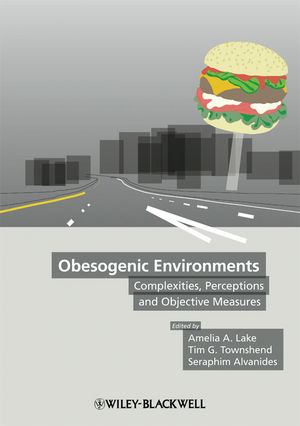
Obesogenic Environments
Wiley-Blackwell (Verlag)
978-1-4051-8263-8 (ISBN)
- Titel ist leider vergriffen;
keine Neuauflage - Artikel merken
Brings together expertise from across a range of disciplines
Written by a truly multidisciplinary team of international authors
Presents some of the most innovative thinking in the battle against obesity
This groundbreaking book brings together for the first time the knowledge of experts with backgrounds in nutrition and dietetics, policy, epidemiology, environmental sciences, medical sciences, town planning and urban design, transport, geography and physical activity in order to offer a multidisciplinary approach to public health, suggesting new and exciting ways to shape our environment to better support healthful decisions.
Dr Amelia A Lake, Senior Lecturer in Food and Nutrition, Applied Biosciences, School of Applied Sciences, Northumbria University, Newcastle, UK Tim Townshend, Director of Planning and Urban Design & Senior Lecturer in Urban Design, School of Architecture, Planning & Landscape, Newcastle University, UK Dr Seraphim Alvanides, Reader in GISc and the Built Env, Northumbria University, UK
Contributors. About the editors.
Dedication.
Acknowledgements.
1. An international perspective on obesity and obesogenic environments (WPT James, R Leach & N Rigby).
1.1 Introduction: the emergence of obesity.
1.2 The magnitude of the problem.
1.3 The basis for the current underestimated burden of obesity.
1.4 Individual susceptibility to weight gain and the persistence of obesity.
1.5 The environmental basis for the obesity epidemic.
2. Towards transdisciplinary approaches to tackle obesity (Tim G Townshend, Louisa Ells, Seraphim Alvanides, Amelia A Lake).
2.1 The focus on interdisciplinary research.
2.2 Defining modes of interdisciplinarity.
2.3 The complexity of obesity.
2.4 The challenge of interdisciplinary understanding.
2.5 Interdisciplinary policy and practice.
2.6 Discussion.
3. Walkabilility, Neighbourhood Design, and Obesity (Jennifer Robertson-Wilson and Billie Giles-Corti).
3.1 Introduction.
3.2 What is walkability?
3.3 Measuring walkability.
3.4 Linking neighbourhood design aspects of walkability to obesity.
3.4.1 Walkability and obesity.
3.5 Breaking down walkability.
3.6 Urban sprawl, geographic location and obesity.
3.7 Other design features and obesity.
3.8 Neighbourhood design as a moderator.
3.9 Summary of findings and future directions in research on the impact of neighbourhood design and/or walkability and obesity?
3.10 Summary.
4. Availability and accessibility in physical activity environments (Andy Jones & Jenna Panter).
4.1 Introduction.
4.2 The concept of availability and accessibility.
4.3 Perceived and objective measures of the physical activity environment.
4.4 Comparing perceived and objective measures.
4.5 Relationships with utilisation.
4.6 Equity of access and facility provision.
4.7 Conclusions.
5. Defining and mapping obesogenic environments for children (Kim L. Edwards).
5.1 Children’s obesogenic environments.
5.2 Advantages of mapping obesogenic environments in children.
5.3 How to map obesogenic environments – data representation.
5.4 Problems with spatial data.
5.5 Spatial analysis techniques.
5.6 Conclusion.
5.7 Acknowledgements
6. Objective measurement of children's physical activity in the environment :UK perspective (Ashley Cooper & Angie Page).
6.1 UK policy and research context.
6.2 A brief review of current studies in the United Kingdom.
6.3 Objective measurement in physical activity research.
6.4 Conclusion.
7. Physical activity and environments which promote active living in Youth (US) (H. Mollie Greves Grow, Brian E. Saelens).
7.1 Introduction.
7.2 Case examples.
7.3 School and child care.
7.4 Community settings (home/neighbourhood).
7.5 Conclusions and future research.
8. Active travel (Roger Mackett).
8.1 The potential for active travel.
8.2 Trends in active travel.
8.3 Barriers to active travel.
8.4 Overcoming the barriers to active travel.
8.5 Policies and measures to increase the volume of active travel.
8.6 The effectiveness of policies and measures to increase the volume of active travel.
8.7 Conclusions.
9. Greenspace, obesity and health: evidence and issues (Caroline Brown).
9.1 Introduction.
9.2 Green space, health and obesity.
9.3 Green space, obesity and food.
9.4 Green space and physical activity.
9.5 Green space and children’s health.
9.6 Green space provision and policy.
9.7 Conclusions.
10. Eating behaviours and the food environments (K Ball, D Crawford, A Timperio, J Salmon).
10.1 Introduction.
10.2 Which eating behaviours influence obesity risk?
10.3 What do we know about the influence of the food environment on eating behaviours?
10.4 Adults.
10.5 Children and adolescents.
10.6 Summary of evidence.
10.7 How should we interpret existing evidence?
10.8 Defining the neighbourhood environment.
10.9 Conclusions and future research directions.
11. Food policy and food governance - changing behaviours ( A Lake & J L Midgley).
11.1 Introduction.
11.2 Dietary guidelines and recommendations with reference to obesity prevention.
11.3 Individual versus the environment.
11.4 Food policy.
11.5 Food provision and food access.
11.6 Future for food policy.
12. Neighbourhood histories and health: social deprivation and food retailing in Christchurch, New Zealand, 1966 to 2005 ( Jamie Pearce & Peter Day).
12.1 Introduction.
12.2 Results.
12.3 Discussion.
12.4 Conclusion.
12.5 Acknowledgement.
13. Environmental correlates of nutrition and physical activity: moving beyond the promise (FJ van Lenthe and J Brug).
13.1 Introduction.
13.2 Environmental correlates of physical activity and diet: underlying reasons for promising findings.
13.3 Environmental correlates of physical activity.
13.4 Environmental correlates of diet.
13.5 Moving beyond the promise: a research agenda.
13.6 Concluding remark.
14. Obesogenic environments: challenges and opportunities (Seraphim Alvanides, Tim G Townshend, Amelia A Lake).
14.1 Introduction.
14.2 Complexities.
14.3 Perceptions.
14.4 Objective measures.
14.5 Future directions.
Index.
| Verlagsort | Hoboken |
|---|---|
| Sprache | englisch |
| Maße | 175 x 246 mm |
| Gewicht | 445 g |
| Themenwelt | Medizin / Pharmazie ► Gesundheitsfachberufe ► Diätassistenz / Ernährungsberatung |
| Medizin / Pharmazie ► Medizinische Fachgebiete | |
| Studium ► Querschnittsbereiche ► Epidemiologie / Med. Biometrie | |
| ISBN-10 | 1-4051-8263-6 / 1405182636 |
| ISBN-13 | 978-1-4051-8263-8 / 9781405182638 |
| Zustand | Neuware |
| Haben Sie eine Frage zum Produkt? |
aus dem Bereich


